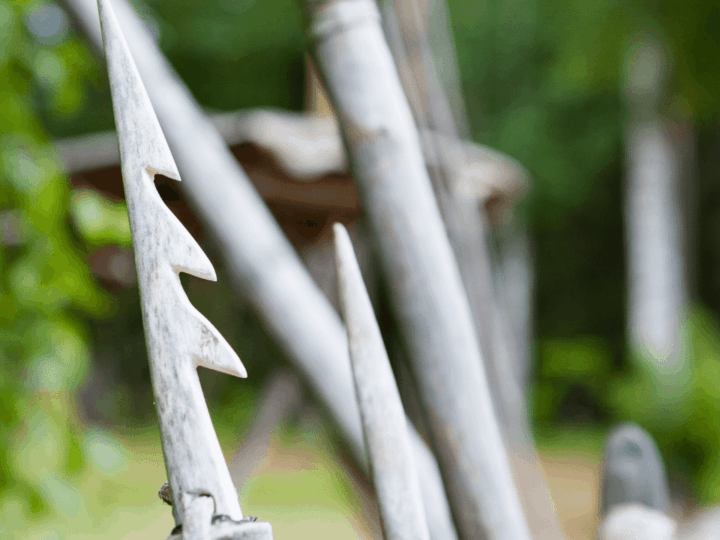Have you ever had the bad luck to be trapped on a desert island without food or water and only a knife for a tool? Well, me neither! But what I have done is wonder if I’d survive the adventure, and yeah, I think I’d stand a good chance if the island had one or more handy streams or coves and bays teeming with fish. Then I’d know I could fish my way to a healthy diet.
I’d start by making a fishing spear because it’s so easy to make a really good one. Now let me tell you how to make a strong and practical fishing spear.
Table of Contents
How to make a fishing spear?
Here’s the basic plan:
- Find a suitable piece of wood
- Decide whether to make a simple or 4-pronged fishing spear
- Make a simple spear, or
- Make a 4-pronged spear
Find a suitable piece of wood
It is important to choose the right kind of wood for the staff of your fishing spear. A great piece of wood will be thin, long, and straight. Spears made from the wrong kind of wood are hard to use and will snap at the drop of a hat (usually at exactly the wrong moment). Deadwoods crack way too easily, so they are useless for making fishing spears.
To get a good piece of wood for your fishing spear:
- Begin by cutting a suitable branch off a tree.
- Make sure the branch is only about as thick as a broomstick handle.
- Select one as straight as possible.
- Measure out the correct length for your spear, which is easy.
Stand up straight with the piece of wood upright next to you. Make a mark in the wood just a little above your head, and cut it off there. Done! You now have the right-sized wood.
Decide whether to make a simple or pronged fishing spear
Once you’ve found and prepared the wood for the staff of your fishing spear, you have to decide what kind of spear you need to make. What sized fish will you be hunting? Small fish (say smaller than 10 inches or so) are better hunted with a pronged spear. Although pronged spears don’t enter deep into fishes’ bodies, pronged spears make it more likely that you will capture small fish.
On the other hand, if your target fishes are longer than 10 inches, pronged spears won’t be helpful because they will not penetrate the fishes deep enough to catch them, and most of your targets will escape.
Make a simple spear
Strip the bark of the shaft to about six inches down from the tip. Hone the tip into a sharp point with a knife (or a sharp rock, if you haven’t got a knife). If you have good wood-carving skills, carve one or more backwards-facing hooks to ensure that stabbed fish can’t slip off the spear… and you’re done! (See? I told you it was easy.)
Make a 4-pronged spear
You’ve seen how easy it is to make a simple spear. Pronged spears are harder to make, but they are precisely what you need to catch small fish. Pronged fishing spears definitely increase your chances of hitting your target. However, as I said earlier, prongs don’t enter deep into the fish.
When making a pronged spear, the first thing you should do is protect the shaft with lashing. Use a rope or cord for this. You need to protect the shaft because you are going to split the wood, and you certainly don’t want to split to go all the way down and ruin your spear!
Tie the cord around one inch from where the prongs will end. The end with the prongs is obviously the sharp end of your spear. So, for six-inch prongs, tie the cord about seven inches from the sharp end. Tie the cord as tight as possible. Strip the bark of the wood from the cord to the tip.
Now split the sharp end in two with your knife. Go down about six inches, leaving one inch between the bottom of the (two) prongs and the top of the lashing. Turn the spear 90° and split the spear in two again. Once more, go down about six inches, stopping near where you did earlier. You will now have four prongs.
Place a twig between opposite prongs and gently knock it downwards. This will open up the first two prongs. Use another twig and do the same thing to open up the final two prongs. You will now have a well-shaped, pronged fishing spear.
Fasten the wedging twigs into place securely. Now sharpen the prongs with a knife, then dry them over a fire as discussed next.
Dry Your Spear
No matter which type of spear you’ve decided to make, if you followed my advice to the letter, your spear’s wood will still be moist (since it came from a living tree), making it essential to dry the wood to ensure it is lighter and stronger. There’s no need to dry the entire spear, but just the tip. Dry the wood over an open fire, but avoid putting it directly into the flames. When done and the wood has dried, it should be a golden brown.
Frequently Asked Questions About Making A Fishing Spear
What kind of wood should I use for the staff of a fishing spear?
The best kind of wood is a hardwood that’s slightly taller than you and about as thick as a broomstick handle. The wood should come from a live tree because deadwood cracks easily and is likely to break–especially when it is least convenient.
How do I know whether a piece of wood is softwood or hardwood?
You can tell the difference between softwoods and hardwoods by using your fingernail. If you press your thumbnail against a piece of softwood, your nail will leave a scratch mark. The softer the wood, the deeper the scratch. The kind of wood to use for your fishing spear is wood which your thumbnail cannot scratch.
Afterword
A fishing spear isn’t hard to make. The right piece of hardwood and some rope are all you need to make an excellent fishing spear. Use the fingernail test (discussed earlier) to make sure the wood you choose is hard enough. The hardest part of fishing with a spear isn’t making the spear, it’s using it. Still, if I can fish with a spear, believe me, you can too.

